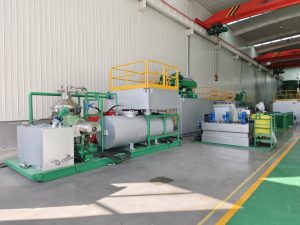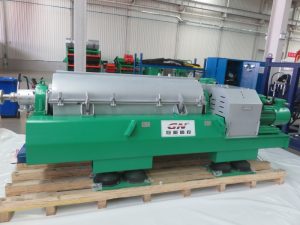Introduction
Oil sludge, a combination of oil, water, and solids, is tough to manage and poses a significant environmental risk. The GNOST-05C oil sludge treatment system, which is both efficient and eco-friendly, offers a new approach to sludge treatment on a global scale.

Oil Sludge Treatment Composition
The GNOST-05C oil sludge treatment system comprises four key components:
- Pre-mixing Tank Module: This is the initial stage where oil sludge is thoroughly mixed with specific chemicals to prepare it for effective separation.
- Chemical Dosing Module: Depending on the characteristics of the sludge, chemicals are accurately dosed to enhance separation efficiency.
- Three-phase Decanter CentrifugeModule: Leveraging strong centrifugal force, this module separates solids and liquids in the sludge into three distinct phases.
- Three-phase Disc Separation MachineModule: Following the decanter centrifuge separation, this module further divides the liquids of varying densities, ensuring a comprehensive separation.

What You Can Get From The System
Efficient oil sludge treatment is crucial not only for resource recycling but also for safeguarding the environment. By utilizing the GNOST-05C oil sludge treatment system, we can:
- Recycle Oil and Water: The extracted oil can be sold to refineries, and the reclaimed water can be reused for thermal washing, facilitating resource conservation.
- Cost-effective Solid Waste Management: The solids, with reduced oil content below 2%, can be treated via thermal desorption or biodegradation, enabling safe disposal.
- Environmental Protection: By minimizing the environmental pollution caused by oil sludge, we contribute to sustainable development.
Distinct Features of this System
Synergistic Benefits of Combining Three-phase Decanter Centrifuge and Three-phase Disc Separation Machine
The integration of the three-phase decanter centrifuge and the three-phase disc separation machine offers remarkable advantages in material treatment, significantly boosting overall separation efficiency. Here’s a closer look at how these two technologies complement each other:
- Enhanced Separation Efficiency:
- Decanter Centrifuge (Separation Factor: ~3000G): This machine excels in handling materials with higher solid content. It performs a preliminary separation, reducing the complexity of the material stream.
- Disc Separation Machine (Separation Factor: ~12000G): Thanks to its higher separation factor, this machine can more effectively differentiate between liquids of varying densities. The resulting liquid phase is notably clearer.
- Sequential Processing for Optimal Results:
- In practical applications, materials typically undergo an initial separation process in the decanter centrifuge. This step helps to prepare the material for the next phase by reducing the solid content and simplifying the mixture.
- Subsequently, the pre-treated material is fed into the disc separation machine for further refinement. This sequential processing ensures that each machine operates within its optimal range, maximizing the overall separation effect.

By leveraging the strengths of both technologies, the combined system achieves a level of separation that would be difficult to attain with either machine alone. This synergy not only improves the quality of the separated components but also enhances overall operational efficiency and cost-effectiveness.